Daphnetin is widely utilized in research focused on:
- Pharmaceutical Development: Daphnetin has shown potential as an anti-inflammatory and antioxidant agent, making it a candidate for developing new medications targeting chronic diseases.
- Cosmetic Formulations: Due to its skin-protective properties, it is incorporated into skincare products to enhance skin health and provide anti-aging benefits.
- Food Industry: As a natural antioxidant, Daphnetin can be used in food preservation, helping to extend shelf life and maintain quality in various food products.
- Agricultural Applications: It has been studied for its potential use in plant protection, acting as a natural pesticide or growth enhancer, which can benefit sustainable farming practices.
- Research in Cancer Therapy: Preliminary studies suggest that Daphnetin may inhibit tumor growth, making it a subject of interest in cancer research for developing novel therapeutic strategies.
General Information
Properties
Safety and Regulations
Applications
Daphnetin is widely utilized in research focused on:
- Pharmaceutical Development: Daphnetin has shown potential as an anti-inflammatory and antioxidant agent, making it a candidate for developing new medications targeting chronic diseases.
- Cosmetic Formulations: Due to its skin-protective properties, it is incorporated into skincare products to enhance skin health and provide anti-aging benefits.
- Food Industry: As a natural antioxidant, Daphnetin can be used in food preservation, helping to extend shelf life and maintain quality in various food products.
- Agricultural Applications: It has been studied for its potential use in plant protection, acting as a natural pesticide or growth enhancer, which can benefit sustainable farming practices.
- Research in Cancer Therapy: Preliminary studies suggest that Daphnetin may inhibit tumor growth, making it a subject of interest in cancer research for developing novel therapeutic strategies.
Documents
Safety Data Sheets (SDS)
The SDS provides comprehensive safety information on handling, storage, and disposal of the product.
Product Specification (PS)
The PS provides a comprehensive breakdown of the product’s properties, including chemical composition, physical state, purity, and storage requirements. It also details acceptable quality ranges and the product's intended applications.
Certificates of Analysis (COA)
Search for Certificates of Analysis (COA) by entering the products Lot Number. Lot and Batch Numbers can be found on a product’s label following the words ‘Lot’ or ‘Batch’.
*Catalog Number
*Lot Number
Certificates Of Origin (COO)
This COO confirms the country where the product was manufactured, and also details the materials and components used in it and whether it is derived from natural, synthetic, or other specific sources. This certificate may be required for customs, trade, and regulatory compliance.
*Catalog Number
*Lot Number
Safety Data Sheets (SDS)
The SDS provides comprehensive safety information on handling, storage, and disposal of the product.
DownloadProduct Specification (PS)
The PS provides a comprehensive breakdown of the product’s properties, including chemical composition, physical state, purity, and storage requirements. It also details acceptable quality ranges and the product's intended applications.
DownloadCertificates of Analysis (COA)
Search for Certificates of Analysis (COA) by entering the products Lot Number. Lot and Batch Numbers can be found on a product’s label following the words ‘Lot’ or ‘Batch’.
*Catalog Number
*Lot Number
Certificates Of Origin (COO)
This COO confirms the country where the product was manufactured, and also details the materials and components used in it and whether it is derived from natural, synthetic, or other specific sources. This certificate may be required for customs, trade, and regulatory compliance.


